
The sea chubs, also known as rudderfish and pilot fish and in Hawaiian as enenue or nenue, are a family, Kyphosidae, of fishes in the order Perciformes native to the Atlantic, Indian and Pacific Oceans usually close to shore in marine waters.

The greenstripe barb, silver barb or striped barb is a tropical freshwater and brackish ray-finned fish belonging to the family Cyprinidae, the family which includes the carps, barbs and related fishes. This species is found in South Asia. It is the only species in the monospecific genus Bhava.
The Namaquab barb is a species of cyprinid fish. It is the only species in the genus Namaquacypris.

The Chapultepec splitfin, known locally as mexcalpique, is a critically endangered species of fish in the family Goodeidae. It is endemic to Mexico and was originally restricted to lakes and wetlands in the Valley of Mexico, including Lake Texcoco. Through man-made channels it was able to spread to the upper Pánuco River basin. Most native populations disappeared as they were at or near Mexico City, with the waters either being reclaimed, drained, heavily polluted or infested with introduced species. Today the Chapultepec splitfin is only known to survive in three lakes in the Chapultepec park of Mexico City, Lake Xochimilco, Lake Zumpango, Laguna de Tecocomulco northeast of the City where perhaps introduced, and parts of the Pánuco River basin. Most of these remaining populations are small. This species was originally described as Cyprinus viviparus in 1837 by Miguel Bustamante y Septién with the type locality given as "Mexico". In 1860 Pieter Bleeker raised the genus Girardinichthys with a new species Girardinichthys viviparus as its type species, this subsequently proved to be a taxonomy of Cyprinus viviparus.
The Channa barb is a species of ray-finned fish belonging to the family Cyprinidae, the family which includes the carps, barbs and related fishes. It is the only species in the monospecific genus Eechathalakenda, although this species was formerly placed in the genus Puntius. This species is endemic to the Western Ghats in southern India.
Pseudoplacocheilus is a monospecific genus of freshwater ray-finned fish belonging to the family Cyprinidae, the family which includes the carps, barbs. minnows and related species. The only species in the genus is Pseudoplacocheilus cryptonemus which is endemic to Yunnan where it occurs in the upper Salween River and the upper Mekong River basins. It is found in clear waters and uses crevices in rocks to hide in.
Clypeobarbus pleuropholis is a species of ray-finned fish belonging to the family Cyprinidae, the family which includes the carps, barbs and related fishes. This species is found in the Chad Basin in Chad and Cameroon, as well as the Congo Basin in Democratic Republic of Congo, the Republic of Congo and the Central African Republic. This species, as Barbus kemoensis, is the type species of the genus Clypeobarbus.
Hyphalophis is a monospecific genus of marine ray-finned fish belonging to the family Ophichthidae, the snake eels. The only member of this genus is Hyphalophis devius, a species known only from its holotype which was collected in the Lesser Antilles southwest of Grenada.
Kertomichthys is a monospecific genus of marine ray-finned fish belonging to the family Ophichthidae, the snake eels. The only member of this genus is Kertomichthys blastorhinos, a species known only from its holotype which was collected in the Atlantic Ocean in the vicinity of French Guiana.
Parhomaloptera is a monospecific genus of freshwater ray-finned fish belonging to the family Gastromyzontidae, a group which shares the common name hillstream loaches with the family Balitoridae. The only species in the genus is Parhomaloptera microstoma. It lives in fast-flowing streams and grows to a maximum published total length of 8.8 cm (3.5 in). This taxon is endemi to Borneo, occurring in both East Malaysia and Kalimantan.

Bangana is a genus of fish in the family Cyprinidae, the carps and minnows. It is distributed across much of southern and eastern Asia. Species live mainly in the flowing waters of tropical and subtropical rivers.

The Kantaka barb is a species of cyprinid fish endemic to the Western Ghats, India. It inhabits large streams, and grows to 15.0 cm (5.9 in) TL.
Prolabeo is a monospecific genus of freshwater ray-fiined fish belonging to the family Cyprinidae. the family which includes the carps, barbs and related fishes. The only species in the genus is Prolabeo batesi, a species endemic to Sierra Leone.

Rohtee is a monospecific genus of freshwater ray-fiined fish belonging to the family Cyprinidae. the family which includes the carps, barbs and related fishes. The only species in the genus is Rohtee ogilbii, the Vatani rohtee, which is endemic to the northern Western Ghats in southern India.
Foerschichthys flavipinnis is a species of fish in the family Nothobranchiidae native to the western African nations of Ghana, Togo, Benin and Nigeria. This species grows to a length of 3.5 centimetres (1.4 in) TL. It is the only known member of its genus. This species was described by Herman Meinken as Aplocheilichthys flavipinnis in 1932 with the type locality given as being near Lagos in Nigeria.

Pseudocaranx is a genus of ray-finned fishes from the family Carangidae, the jacks, trevallies, scads, and pompanos. They occur in the western Atlantic Ocean and the Indo-Pacific.
Paruroconger is a monospecific genus of marine ray-finned fish belonging to the subfamily Congrinae, the conger eels, in the family Congridae, which also includes the[[garden eel]s. The only species in the genus is Paruroconger drachi, an eel which is known only from the holotype collected in the Eastern Atlantic Ocean off Pointe-Noire in the Republic of Congo.
Malapterus reticulatus is a species of wrasse endemic to the Juan Fernández Islands in the southeastern Pacific Ocean. It is a cleaner of species in the genus Scorpis, eating the isopod ectoparasites in their mouths. This species is the only known member of its genus. It is found in shallow, coastal waters over rocky reefs.
The Coquito sergeant, also knowns as the Coquito damsel, is a species of ray-finned fish, it is the only species in the monotypic genus Nexilosus which is classified in the family, Pomacentridae, the clownfishes and damselfishes. It is found on rocky coasts in the eastern Pacific Ocean off Peru and northern Chile, as well as the Galapagos Islands.

The school bass is a species of marine ray-finned fish, it is the only member of the monotypic genus Schultzea which is part of the subfamily Serraninae which itself is classified within the family Serranidae, along with the anthias and groupers. It is found in the western central Atlantic Ocean. This species is found in deeper waters near coral reefswhere it forms small groups which feed on plankton. The school bass is a synchronous hermaphrodite. The generic name honours the American ichthyologist Leonard Peter Schultz (1901-1986) who was Curator of Fishes at the United States National Museum who examined the specimens described by Loren P. Woods (1914-1979) as Schultzea campachanus, which was later shown to be a synonym of Hildebrand's Serranus beta.








